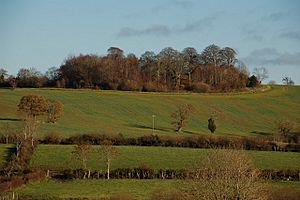Lisnagade facts for kids
Lisnagade is an ancient ringfort located about three miles west of Banbridge in County Down, Northern Ireland. It's a very large fort made of earth, known as a "multivallate" fort because it has many walls or banks. The name Lisnagade comes from an old Irish phrase meaning "fort of the hundred." This special place is protected as a State Care Historic Monument.
Contents
What is Lisnagade Fort?
Lisnagade is a really impressive circular earthwork. It has three huge banks, each about 6 meters (20 feet) high, separated by deep ditches. These banks completely surround the fort. The inner circle of the fort is about 60 meters (200 feet) across. The entire fort, including all the banks, measures about 110 meters (360 feet) wide.
There's also a smaller, lower fort connected to the main one on the north side. This smaller fort is about 30 meters (100 feet) wide and has just one ditch around it.
History of Lisnagade
This ancient site is over 1000 years old! Experts believe it was built around 350 AD. We don't know much about the people who lived here, even though some old bronze objects have been found. Today, the inside of the fort has low plants and a large beech tree. The banks are covered with various trees and small bushes.
Discoveries at the Fort
In 1837, a book called Lewis's Topographical Dictionary of Ireland described Lisnagade. It said the fort was one of the biggest and best-preserved of its kind. The entrance is from the east, leading into a large circular area. From here, you can see the countryside for miles around. Many other forts or "raths" can be seen from Lisnagade. This is why some people think it got its name, meaning it was the main fort among a hundred others.
The ditches around the fort are very deep. It's interesting that they were paved at the bottom with rounded pebbles set in clay. In 1832, when the ditches were being cleaned, many silver coins were found. Other discoveries included a brass cauldron, spear-heads, and other old items. Many arrowheads and spear-heads made of flint, stone, and brass have also been found.
In 1807, the head and antlers of a huge elk were discovered near the fort. Several other elk remains were found in the bog marl nearby. Other treasures found in the area included parts of a gold tiara, bronze swords, and spear-heads.
Past Events at Lisnagade
Lisnagade Fort has seen some important events. In 1783, a battle took place here between two groups called the "Hearts of Steel" and the "Break-of-day Boys." Several people from the "Hearts of Steel" group were killed during this fight.
Later, in 1789, there was another clash at Lisnagade. A group of Protestants from Loughbrickland were on their way to a special event when they met Catholics at the fort. This event became known as the "Lisnagade Riot." Twelve Catholics were arrested at first, but they were later set free.
Trouble continued in the area. In 1790, the Lisnagade Mass House (a church) was burned down. People blamed a group called 'Clarke's Wreckers' for this attack. It's said the attack happened during a Mass service. A new church, St. Mary's Church, was built a few years later to replace the one that was destroyed.


